Caving in Gunung Mulu National Park
 We are going caving in Sarawak for the weekend. A package deal of 2 nights and 3 days will only cost $250 each. A direct flight takes us to Miri where a smaller plane drops us off in Mulu. Miri is a coastal city remote from the capital nestled up against Brunei. Once we reach Mulu, it dawns on me that the people in these more rural places will be more traditional. Indeed they are, with women on the streets and paths carrying traditional rattan baskets suspended by tump lines. Even people riding motorbikes are likely to carry a traditional baskets and wear a conical straw hat.
We are going caving in Sarawak for the weekend. A package deal of 2 nights and 3 days will only cost $250 each. A direct flight takes us to Miri where a smaller plane drops us off in Mulu. Miri is a coastal city remote from the capital nestled up against Brunei. Once we reach Mulu, it dawns on me that the people in these more rural places will be more traditional. Indeed they are, with women on the streets and paths carrying traditional rattan baskets suspended by tump lines. Even people riding motorbikes are likely to carry a traditional baskets and wear a conical straw hat.The fancy Royal Mulu Lodge is right in the Gunung Mulu National Park about ten minutes from the airport in Mulu. Gunung Mulu is a World Heritage Area which encompasses a series of accessible caves including Deer Cave, the largest in the world. In some of the caves in the region, people still harvest swiftlet nests high inside the caves for the tasty but expensive Bird’s Nest soup. Long lengths of bamboo ladders are positioned to extract the nests in
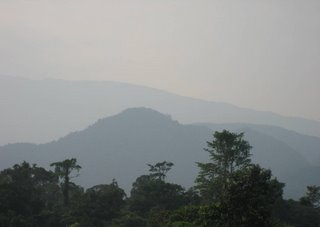 a sustainable way. Bird’s nests have been a top foreign export of Sarawak for centuries. Unfortunately for us those caves are not open to tourists. We are greeted by our guide at the airport and taken by van to the Lodge. Waiting for us at the hotel which is laid out like a giant longhouse, are fresh chilled mango juice and a complimentary face wipe. This is the life!
a sustainable way. Bird’s nests have been a top foreign export of Sarawak for centuries. Unfortunately for us those caves are not open to tourists. We are greeted by our guide at the airport and taken by van to the Lodge. Waiting for us at the hotel which is laid out like a giant longhouse, are fresh chilled mango juice and a complimentary face wipe. This is the life!At 2 pm the first day we head off to the first two caves. Dense vegetation clings to every surface on the two hour walk through the rain forest to Langs Cave and Deer Cave. We move on a wooden path a couple of feet off the ground. We are warned not to touch the side rails as there are many insects that sting. The guide is an young Kenyah woman with reasonable English. Travelling in the afternoon is not the best time to see animals or birds which are all sheltering from the heat but we find many fascinating insects and butterflies. A caterpillar that looks like it has a fur coat with the guard hairs still attached. A stick insect is so much like a stick that I truly do not see for the
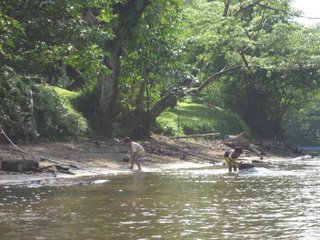 longest time although I am looking right at it. As we move closer to the caves, a round bug with red circular stripes appears more frequently on the sides of trees.
longest time although I am looking right at it. As we move closer to the caves, a round bug with red circular stripes appears more frequently on the sides of trees.An ancient river bed scalloped the walls and floor of Deer Cave while ongoing work by the elements on the limestone creates stalagmites and stalagtites. Along the ceiling there are rippling folds of rock and round protuberances as well as the thin etched creations connecting the top and bottom of the cave throughout. In one section of the cave, guano lies several feet deep below the boardwalk. The smell of ammonia is so strong we cover our noses with handkerchiefs or hats as we pass over it. Thousands of bats live high in the roof of the caves.
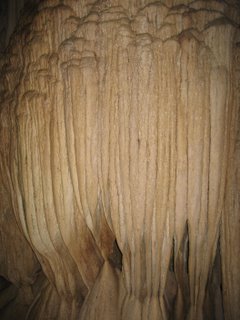
The complex cave passages wind their way through the limestone mountains into chambers which are so large they astound. Stairs take us close to the top of one section in the largest natural rock chamber in the world where we can view the soft bodies of bats clinging to the walls. We come across a number of workers and researchers in the depths of the cave and spot snakes lurking in the formations at several spots. There is one rock formation that looks surprisingly like the profile of Abe Lincoln and others that resemble animals.
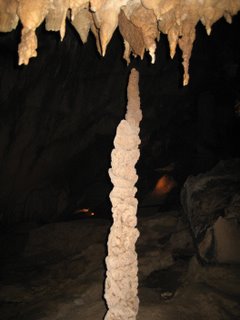
Langs Cave is just next to Deer Cave about 100 m. away. We stop for cold drinks at the Bat Observatory just outside the caves before we head back. At 5 pm most evening there is a spectacular bat migration. Today it starts to rain lightly at 4pm. Others in the group opt to wait to see if the rain stops so they can see the bat migration but we head back. I have tried to explain bat migration to friends, without success, how bats blanket the sky with a eerie chittering just a short interval before dusk and after dawn. It seems as if there is nothing else except them for a short period and then as if they were never there at all. It is one of the things you have to experience yourself. A Dutch group with us have come specially to see the bat migration so make arrangements to return the next day.

We are happy and muddy when we get back to the air conditioned comfort of our room. The next day we are taken by longboat up the river to Clearwater Cave and the Cave of Winds. We make a short stop at one of the only settlements of Penan. Longboats are tied up at the river edge. The community has set up stalls for handicrafts where we are able to purchase the beautiful black and tan rattan bags of exquisite design, patterned mats as well as jungle produce such as snake fruit and bamboo shoots. Older women with extended earlobe loops sell baskets. The homes are unpainted wood shacks, people are bathing in the river and lines of clothing are strung out in the sun to dry, a testament to the industry of the women. A satellite dish sticks out of the edge of one shack. A small naked girl idly watches me from her porch. Like many of such dislocations of normadic people, it doesn’t look like a very successful experiment.
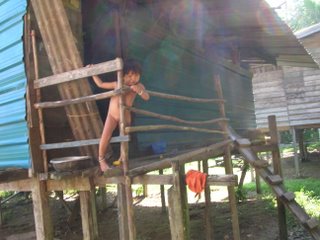
We stop briefly at the National Park Center for our lunch. There are groups of pitcher plants and orchids of many varieties on display. We decide after a quick look at the water in Clearwater Cave not to swim in it. There are also arduous hikes in the area including the overnight hikes to the limestone Pinnacles and the Mulu Canopy Skywalk we don’t take.
At night we are treated to the best cultural display we have seen in Sarawak. It includes various cultural dances, blow pipe display, bamboo pole dancing and even someone twirling on a pole balanced on his stomach high above the crowd. The costumes are exquisite, the choreography excellent and the exuberance of the staff, who also serve us our dinner, is grand.
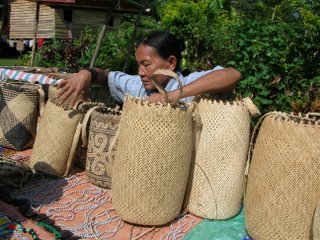
We have a couple of hours in Miri waiting for our plane connection so we hire a taxi to take us into the town. This proves to be an inspired decision as our driver goes out of his way to show us around his home town. A local park has reproduced a version of the canopy walk for which the region is famous and the handicraft stores are packed with local articles. We are tired but satisfied when we reach home.
As my time in Sarawak comes to a close, the multiple choice questions (MCQs) I have put off writing threaten to overwhelm. Sets of new MCQs are needed every year. In a country where English is a second, third or fourth language, MCQs are not the best way to measure competency or appreciation. Supposedly MCQs capture recognition, although I find I am doubting this too. MCQs are popular largely because they are easy to mark and for students, no composition or grammar are needed.
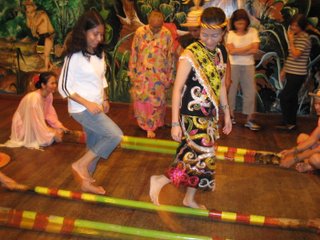
They aren’t easy to write. They rely in large part on language facility and tricks in wording. In best answer questions, several answers will be right but only one is the best possible answer. We have just completed the orals for the end of the community medicine rotation in fourth year. It has been 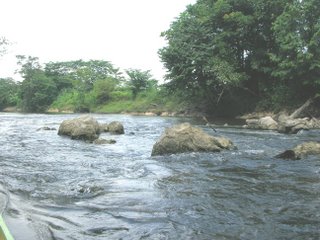 an exercise about the crucial importance of simple phrasing and clear language without which the students don’t even understand the question. l am attempting to write simple, clear MCQs with varying results. I am getting more and more agitated as I try to match my original objectives up with questions that focus almost entirely on knowledge of facts. My colleagues, who have exactly the same kind of problem, make soothing gentle reassurances many of which end in lah. The lah is also extended to the English translation.
an exercise about the crucial importance of simple phrasing and clear language without which the students don’t even understand the question. l am attempting to write simple, clear MCQs with varying results. I am getting more and more agitated as I try to match my original objectives up with questions that focus almost entirely on knowledge of facts. My colleagues, who have exactly the same kind of problem, make soothing gentle reassurances many of which end in lah. The lah is also extended to the English translation.
“It’s OK, lah. Don’t worry, lah.”
”Lah-ing” is a wonderful softening device if ever there was one, so Malaysian. Malaysians are a gentle, kind people. Even when you are annoyed with them, you are deflected by their innate kindness. Proverbs often extract the essence of cultures.
One can pay back the loan of gold but one is forever in debt to those who are kind.
Malay Proverb
Our MPH students come over for a Burmese Laksa lunch which is similar to but not the same as Penang Laksa. The Burmese require the thick shrimp and fish sauce to have exactly the right amount of lemon grass, so much tasting goes into getting it just right. The fish-shrimp sauce is ladled over different types of noodles with hard-boiled eggs, fried garlic, deep fried dahl paste, a dollop of hot pepper, chopped cucumbers and coriander on the side and lime juice squeezed on top.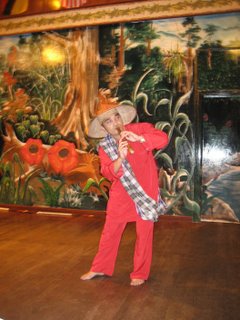
It is also durian time so we are treated to Indonesian durian, not quite so good as Sarawak durian as I am told repeatedly. Three large spiked fruits are cracked open on the table and we help ourselves to the fleshy, succulent fruit. A treat someone’s father has brought back from his trip to locate enough durian to pickle.
The students present me with a Iban beaded top that circles my neck and extended over the whole upper body in cascades of bright triangles of design. I greatly admire the traditional Iban costumes seen mostly in dancers, which flow sedately from side to side emphasizing their hand and leg movements but until I put this beaded top on, was unaware of the kinesthetic experience of wearing one. The beads are heavier than they look and feel like a sustained hug that shimmers when you move. It makes you feel enclosed and protected as well as out there dazzling the world. What an amazing feeling and delightful surprise. This is of course the way with costumes of all sorts. You really do feel as well as look different in them, but the Iban have managed to distill an experience in this beaded dancing top.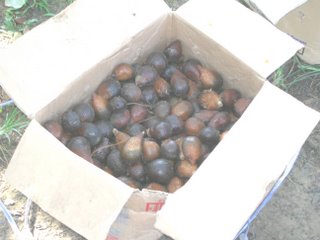
One last task is to attend the student presentations of the community placement elective. They have worked hard and incorporated our previous comments. The written report is superb. They answer our questions well. Their analysis is detailed and their intervention was creative. The PowerPoint presentation is a tad lengthy with something like 125 slides. Afterwards they crowd around excitedly to show us their video of the placements. A group of them have, in addition to everything else, done a 10 minute movie of the whole placement from the community visits, setting up their rooms and bed nets, interviewing villagers, home visiting and the health education sessions. The video is professional and slick with fades, background music and stunning photography. It would make a good advertisement for the medical school’s community based programs. We tell them they should put it on You-Tube and show it to the dean. They are shy but pleased. The video better captures the richness of the community program and the connection students have established with the village than any exams will ever do. The Malaysians were right, one shouldn’t worry about MCQs.
Labels: Sarawak


8 Comments:
Great post and beautiful pictures!
Good post!
What an incredible cultural experience you have had there! Thank you for sharing it here.
So how big is the biggest cave in the world? I've been to Mammoth Caves in Kentucky and Carlsbad Caverns in New Mexico and thought they were pretty impressive.
And what is in that box in the last photo? Looks like chestnuts.
Will you plan to return next summer? Those of us who enjoy your stories can only hope so!
I really enjoyed this post.
Thank you for coming to Sarawak, the Land of the Hornbills. Spread the word about this wonderful eco-tourism place. The nature, the tribes, the food and the adventure. I'm proud to be from Sarawak.
I used to spelunk in some caves in NW Georgia. My favorite was Byers' Cave ... it used to take a few hours to get into the body of the cave itself. We worked with ropes, lights on our hats which were powered by large batteries, and carried extra gloves and knee pads.
Once in there, you could visit underground rivers and waterfalls ... each time in and out was an unforgettable experience.
About "lah-ing" ... what exactly does "lah" mean?
I hope that you're not going to stop writing once you've no longer in Sarawak ...
Thank you all. "lah" is as far as I know, doesn't mean anything. But it does soften. The box is full of snake fruit, so called because the peel looks like snake skin, it has a subtle but interesting flavor. Mulu caves are not as well lighted as NA ones and have because of that a wonderful eerie sense and are full of creatures and immense.
mann i love bird's nest soup too even IF its made from spit!!! <333
i eat it like once every monthish and used to bought from website hongkong-bird-nest.50webs.com/index_e.htm sometimes, my mom went back to hong kong and bought a full suitcase of it cause its cheaper there XD
Post a Comment
<< Home